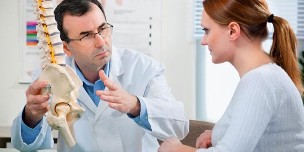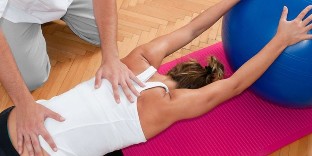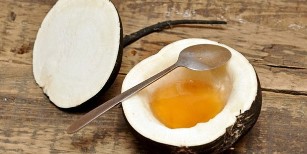In the medical literature, the term "spinal osteochondrosis" means degenerative processes in ossification centers in children. A common medical disease, which is considered to be the most common among all the problems of the musculoskeletal system, is hidden behind the words sciatica, disc herniation, dorsalgia (back pain). The lower back, according to official statistics, suffers more often than other parts, which leads to serious complications for the whole body. Why does this happen and how to treat osteochondrosis?
What is osteochondrosis of the lumbar spine
Degenerative neuro-orthopedic disease that affects the intervertebral discs and leads to secondary compensatory and reactive changes in the osteo-ligamentous apparatus and nervous system - this is the definition given by osteochondrosis doctors. It mainly affects the lumbar region, which is located between the thorax and the sacrum and consists of five vertebrae. There are discs between them - fibro-cartilaginous formations, formed by the following elements:
- cartilaginous tissue (membrane involved in the feeding of discs by vessels of the vertebral body);
- pulposus nucleus (gelatinous mass in the center with a pulposus nucleus);
- anulus fibrosus (protects part of the fluid).
Against the background of circulatory problems, changes in the composition of cartilage tissue, dehydration of the nucleus pulposus, elasticity and resilience of the intervertebral disc deteriorate, its fixing properties suffer. Under the influence of adverse factors, muscle fixation weakens and the vertebrae gain excessive mobility. Next, degenerative and destructive processes affect the bony surfaces of adjacent vertebrae, dystrophy (tissue malnutrition) of the spine occurs.
The further process looks like this:
- Microquests appear in the liberated anus. The pulposus nucleus begins to penetrate into it, gradually plowing through the annulus fibrosus and being damaged, leading to a disc herniation or elongation (initial stage).
- A hernia compresses the spinal canal, can pinch nerve roots and blood vessels, causing pain and movement problems.
- Due to the increased pressure on the vertebrae (from the thinning of the disc), accelerated production of bone tissue begins and spinous processes (osteophytes) are formed.
Reasons
Some experts tend to call intervertebral osteochondrosis of the lumbar spine and others a "disease of civilization, " mainly because of the standing posture, which has increased the load on the back of a modern person. The disease mainly begins in people over 30 years old, in men it is diagnosed more often than in women.
Lumbar osteochondrosis can develop:

- Excess load on the spine (home, professional, sports);
- weak back muscles;
- incorrect distribution of household load on the spine (for the lumbar spine - the most common reason);
- frequent back muscle tension;
- being overweight, especially against the background of diabetes mellitus;
- spinal cord injuries;
- violation of metabolic processes;
- incorrectly placed shoes, flat feet;
- behavioral problems, resulting in an uneven load distribution along the spine;
- lumbar spine hypothermia;
- sedentary lifestyle, long-term driving;
- hormonal disorders (mainly in women);
- congenital pathologies of the musculoskeletal system; age
- (natural changes in fibrocartilaginous tissue occur in people over 50 years of age);
- frequent stress, emotional stress.
Stages of development
The course of the disease is slow and gradual, with most patients recognizing a serious problem only in stage 2 or later. In the absence of proper treatment, osteochondrosis progresses and can lead to disability.
Main Medical Classification:
- The initial stage is characterized by the beginning of the process of destruction of intervertebral discs, a decrease in their elasticity, their elasticity. The disease makes itself felt mainly with a load on the back.
- Destructive processes affect the fibrosus ring, the distance between the vertebrae is reduced (the disc becomes thinner), the amortization suffers, elongation occurs (extension of the intervertebral disc without breaking the ring). Compression of the nerve roots and inflammation of the tissues occur, which increases the pain syndrome.
- A rupture of the ring fibrosis occurs, a hernia occurs. Vessels, nerve endings are congested. Changes in the lumbar spine lead to a general deformity of the spine.
- In the final stage, the affected section atrophy muscles, motor activity and ability to work suffer. The vertebral column is visibly bent - there is pronounced scoliosis (3-plane deformity), lordosis (hypertrophied forward deviation of the lower back).
Symptoms of lumbar osteochondrosis
Clinical manifestations of the disease depend on the stage of severity. The main symptom is a local pain syndrome that occurs in response to physical activity, heavy lifting, hypothermia of the lower back, prolonged maintenance of an uncomfortable posture (in the sitting position, the load is higher than in the vertical). Caused by irritation of the sinuvertebral nerve (recurrent). The stages of osteochondrosis of the lumbar spine look like this:- In the initial stage, there is discomfort in the lumbar region, the pain is rare, mainly with a high load on the back. They pass quickly.
- In stage 2, the mobility of the lumbar spine deteriorates, the pain occurs after physical exertion and without it (with a strong cough, change in behavior), gradually intensifies, persists for a long time. Malfunctions in the work of internal organs are possible.
- With the development of osteochondrosis, the pain becomes permanent (permanent), and the vertebrae become deformed. The nerve endings are compressed, so the pain can be given to the sacrum, the leg, become sharp, shooting. Loss of sensation of limbs, buttocks, thighs, numbness, paresthesia (burning, tingling, "goose bumps") occur. Disorders of the pelvic organs appear.
- In the last stage, motor function is impaired or becomes completely impossible, curvature of the spine occurs. The pain is permanent, the person subconsciously takes an unnatural position to reduce it.
Reflex syndromes of the disease in official medicine are understood in 3 groups: muscular tonic, neurodystrophic, vegetative-vascular. The last 2 categories appear clearly in 3 stages of the disease and later.
The clinical picture may include:
weakened or missing reflexes of the Achilles tendon, flexion of the fingers (if osteochondrosis of the sacral region is added);Complications
If osteochondrosis of the lumbar spine is diagnosed, treatment should begin immediately, as in the last stage the patient may be completely incapacitated. Against the background of compression (squeezing) of the spinal cord by the vertebrae, between which there is no space left, paralysis of the lower extremities may develop.
Furthermore, osteochondrosis can cause:
- disorders of the pelvic organs (men suffer from erectile function, women - ovarian activity);
- lumbago (acute lower back pain), sciatica (constriction and inflammation of the sciatic nerve);
- intervertebral disc prolapse, stenosis (narrowing of the spinal canal);
- spinal cord lining damage, which is fatal.
Diagnosis
To make an accurate diagnosis and assess the severity of the disease, the doctor collects anamnestic data (study of patient complaints, lifestyle, hereditary factors). After that, a physiological examination is performed, where the patient's motor skills, behavior, level of sensitivity, muscle tone and size and their spasms are evaluated. Knocking with a hammer, the areas of radiation (where given) are marked for pain in lumbar spine osteochondrosis.
Once the patient has been assigned:
- Radiographyis the most accessible way of examining the anatomical parameters of the vertebrae, assessing the tendency for narrowing of the holes between their bases, and identifying bone growths.
- MRI(magnetic resonance imaging) - helps to assess the condition of the vessels that supply the spine, nerve processes, discs.
- CT(computed tomography) - prescribed only to check for changes in vessels, spinal cord lining, and to study marginal growths.
Treatment for osteochondrosis of the lumbar spine
Surgical intervention is considered a last resort, prescribed primarily for patients who have significant neurological disorders and a high risk of disability. These problems are characterized by advanced osteochondrosis of the lumbar spine - doctors try to perform the treatment of stages 1 and 2 according to a conservative method.
Therapeutic measures aim at:
- elimination of pain syndrome;
- removal of muscle spasm, hypertension;
- elimination of the inflammatory process;
- improving blood circulation to the affected areas and metabolic processes;
- normalization of lumbar vertebral motility;
- restore lumbar sensitivity.

There is no universal method of treatment: each specific case of osteochondrosis requires an individual scheme. It is especially important to consider the form of the disease: acute or chronic. Therapy is necessarily of a combined nature, implying the use of medication (internal and external) along with physical manipulations - massage, gymnastics, physiotherapy. The treatment regimen for osteochondrosis of the lumbar spine can be supplemented with acupuncture, hirudotherapy.
The effectiveness of the treatment will increase if you follow the following rules:
- A special belt or corset should be worn during treatment to reduce stress on the spine.
- Excludes physical activity (only those recommended by the doctor remain), so as not to add provocative factors.
- important it is important to closely monitor the diet: cartilage needs sources of collagen (gelatin, aspic, meat of choice) and the whole body needs plant foods, fish, nuts. It is advisable to refuse salty, smoked, pickled products, as well as spicy cheeses, fatty meats.
- The scheme prescribed by the doctor should be followed to the end: do not stop treatment when the main symptoms have subsided, do not change the group of drugs and procedures yourself.
- Along with your doctor, it is worth choosing an orthopedic mattress that will help relax your lower back during sleep and special shoes. Women are completely forbidden from the heel.
Acute osteochondrosis of the lumbar spine requires special attention - its treatment begins with the appointment of the patient to the rest of the bed for a few days. Pain sensations are reduced with injections of analgesics, novocaine blockade and glucocorticoids are not excluded. Spinal traction (using a traction table or vertical apparatus), walking on crutches, electrophoresis, and laser therapy help to improve the condition.
Drug therapy
Medications for the treatment of osteochondrosis of the lumbar spine are used internally and internally. Topical gels and ointments are symptomatic therapy: relief of inflammation and pain, relief of muscle spasm and edema, improvement of blood circulation. In acute conditions, injections are indicated that have an immediate anti-inflammatory, antipyretic, analgesic effect.
:Most doctors prescribe home remedies for osteochondrosis:
- Chondroprotectors- protect cartilage tissue and promote its recovery, indicated for long-term use (from six months or longer).
- Means that improve blood circulation and metabolic processes in tissues- tablets taken for several months, as the effect is cumulative.
- Muscle relaxants- relieve muscle spasm, used orally in a short course.
- Non-steroidal anti-inflammatory drugs- quickly block pain, suppress the production of prostaglandins involved in the inflammatory process. Ointments and gels are applied to the affected area 1-2 times a day, unless otherwise indicated in the instructions. In the initial stages, external forms can be distributed, after which they are copied with tablets.
- Ointments that have a warming effect- help relieve pain and improve blood circulation to tissues, are safer than non-steroidal drugs, but are prohibited in the inflammatory process.
- Group B vitaminsand multivitamin complexes are prescribed over a long course to increase the overall effectiveness of the treatment.
Physiotherapy procedures
In order to increase the effect of medication treatment and speed up recovery, the patient may be prescribed physiotherapy courses. You can alternate them or go through several options at once. The specific technique is chosen according to the stage and form of the disease.
Osteochondrosis of the lumbar spine - treatment includes effective methods:
- Electrotherapy (electrophoresis)- means the effect of low power currents to improve blood circulation to the affected areas.
- Laser therapy- activates biological processes in nerve endings, relieves the symptoms of neuro-dystrophic syndrome.
- UHF- local impact on the lumbar region with a high-frequency magnetic field to stop the inflammatory process, stimulate cell regeneration (tissue restoration), and reduce pain.
- Phonophoresis and electrophoresis- helps distribute medicines to the area that needs them, which increases the effectiveness of medication treatment. The result depends on the specific agent used during the procedure.
- Darsonvalization- a therapeutic effect of high-frequency alternating current aimed at dilating blood vessels, improving blood circulation and nourishing tissues. The procedure affects the symptoms less than the others.
- Amplipulse- local effect of modulated sinusoidal currents, due to which the severity of pain is reduced. The procedure has an analgesic, vasodilator, neurostimulatory effect, improves tissue trophism.
Healing gymnastics
Physical activity - especially when it comes to early osteochondrosis (initial stage) of the lumbar spine - should be included in the treatment: they help to relax the muscles and strengthen them, have a beneficial effect on tissue nutrition. For people with grade 2 disease and more severe exercise, the doctor will choose it. With deterioration, gymnastics, swimming, yoga (the most effective directions) are forbidden.
The following exercises show good results:
- Take an emphasis on your knees and palms, keep your back straight (parallel to the floor). As you exhale, slowly bend your lumbar region, tilting your head slightly back. Count to 5-8 (depending on how you feel), suck and arch your back with a steering wheel. Count to 5-8 again and take the starting position. Exercise is performed 10-12 times at a slow pace. If necessary, they are divided into 2-3 ways.
- Lie on your stomach. During extraction, slowly lift your chest off the floor, leaning on your lower back and trying to get up as high as possible. The arms are stretched forward, the legs do not move. Hold in this position for 5-10 seconds and gradually lower. Repeat the exercise 8-10 times, gradually increasing the duration of the delay to the upper point.
Massage
Massage is an effective method for treating any stage of osteochondrosis, which helps relieve unpleasant symptoms, relieve muscle spasms and normalize lymph outflow and blood supply to the affected areas. Moreover, this procedure stimulates the restoration of atrophied muscles and removes the restriction of vertebral mobility, strengthens the ligament apparatus. The massage is performed by a medical specialist in courses of 10-12 sessions, when the symptoms of the acute phase have subsided.
Surgery
If a patient is diagnosed with significant neurological disorders, loss of control over urination, has a severe hernial extension, surgery is necessary. In addition, the indicator for it is the lack of a positive effect from conservative treatment (lasting more than a month). Before receiving a recommendation for surgery, the doctor should evaluate all the risks, especially if the traditional technology on microdiscectomy is chosen.
During the procedure, the surgeon may:
- remove pathologically altered areas by placing local implants (discectomy), which are developed individually for each patient;
- to line the spine with a special rod - this helps to distribute the load correctly and prevent new deformations.
Discectomy is performed under general anesthesia, the entrance for the surgeon is posterior. During surgery, the skin is cut to a length of 10 cm, the muscles move away and the affected disc is removed. At the end of the procedure, the wound is sutured in layers. The duration of the surgical intervention is about 2 hours, the next day the patient should lie on his back. The rehabilitation period is 2 months. With microdiscectomy, the procedure takes 1. 5 hours, an incision is made by 3 cm, and you can stand up after leaving the anesthetic.
Treatment of osteochondrosis of the lumbar spine with folk remedies

After consulting a doctor who can skillfully assess the patient's condition, it is permissible to use traditional medicine prescriptions. They do not give the same pronounced effect as drug therapy, do not replace physiotherapy, massage and gymnastics, but increase the likelihood of a positive result from the main treatment.
Some simple options:
- Peeled black radish (350 g), combined with liquid honey (250 g) and vodka (100 ml). Use to rub the lower back with light massage movements for 10 minutes in the morning and evening. After that, it is advisable to wrap this area with a woolen cloth and lie down for an hour under a blanket. The procedure is performed for 8-10 days, after which they take a break.
- With severe back pain, you can take 100 g of medium-fat cottage cheese, add 1 teaspoon. apple cider vinegar, place on a cotton cloth or cheesecloth. The bandage is held for 2 hours, the procedure, if necessary, repeated 2 times a day. The duration of treatment is not limited.
- Collect fresh lilac flowers, fill them with a liter vase without pressing. Pour a liter of vodka, leave in a cool place for 3 weeks. Use to rub the affected area once a day for a month. It is not necessary to cover the lower back with anything after processing.
Prevention of osteochondrosis of the lumbar spine
Doctors say that most back diseases can be prevented through regular physical activity, which strengthens muscles, improves blood circulation and tissue nutrition. Osteochondrosis of the lumbar spine is no exception - treatment will not need to be performed if you engage in gymnastics, yoga and swimming systematically.
Additional prevention measures:
- diet control (more plant foods, less animal fats, pickles, marinades: as in treatment);
- limiting large loads on the spine;
- monitoring the state of the endocrine system;
- elimination of bad habits (alcohol, smoking);
- use of an orthopedic mattress;
- behavior tracking;
- avoid high heels (from 7 cm) for women.

























